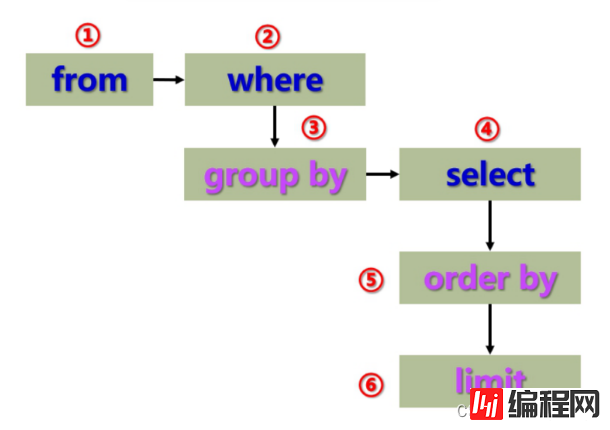目录一、聚合查询(行与行之间的计算)1.常见的聚合函数有:2.group by3.having二、联合查询(多表查询)1.进行联合查询的步骤:2.内连接(from,join on)3.外连接(left/righ
函数 | 说明 |
count | 查询到的数据的数量 |
sum | 查询到的数据的总和(针对数值,否则无意义) |
avg | 查询到的数据的平均值(针对数值,否则无意义) |
max | 查询到的数据的最大值(针对数值,否则无意义) |
min | 查询到的数据的最小值(针对数值,否则无意义) |
Select count(*) from student(统计行数)
Select count(1) from student(统计第一列数据的行数,如果有null则不算行数)
Select sum(math) from student(数学成绩总分)
Select sum(math) from student where math > 60(数学大于60的总分)
Select avg(math+chinese+english) from student(统计平均总分)
Select max(math) from student(数学最高分)
Select min(math) from student where math >60(数学大于60的最低分)select 中使用 group by 子句可以对指定列进行分组查询。使用 group by 进行分组查询时,select 指定的字段必须是“分组依据字段”,其他字段若想出现在select 中则必须包含在聚合函数中。
select column1, sum(column2), .. from table group by column1,column3;
//示例:查询每个角色的最高工资、最低工资和平均工资
Select role,max(salary),min(salary),avg(salary) from emp group by role;group by 子句进行分组以后,需要对分组结果再进行条件过滤时,不能使用 WHERE 语句,而需要用Having
//示例:显示平均工资低于1500的角色和它的平均工资
select role,avg(salary) from emp group by role having avg(salary)<1500; 关于分组查询指定条件有三种情况:
1.分组之前,指定条件(先筛选,再分组)用where
2.分组之后,指定条件(先分组,再筛选)用having
3.分组之前和分组之后都指定条件(先where后having)
关于执行顺序:

多表查询是对多张表的数据取笛卡尔积,笛卡尔积是通过排列组合算出来的,因此包含了很多无效数据,因此需要加上连接条件,用来筛选有效的数据。
1.首先计算笛卡尔积
2.引入连接条件(如:where student.id = score.student_id)
3.再根据需求,加入必要的条件(where where student.id = score.student_id and student.name=’xxx’)
4.去掉多余的列,只保留需要关注的列(select student.name,score.score from student,score where where student.id = score.student_id and student.name=’xxx’)
语法:
select 字段 from 表1 (as)别名1 [inner] join 表2 (as)别名2 on 连接条件 and 其他条件;
select 字段 from 表1 (as)别名1,表2 (as)别名2 where 连接条件 and 其他条件;
示例:查询“张三”同学的成绩
select sco.score from student as stu inner join score as sco on stu.id=sco.student_id
and stu.name='张三';或者
select sco.score from student as stu, score as sco where stu.id=sco.student_id and
stu.name='张三';外连接分为左外连接和右外连接。如果联合查询,左侧的表完全显示我们就说是左外连接;右侧的表完全显示我们就说是右外连接。
语法:
左外连接,表1完全显示
select 字段名 from 表名1 left join 表名2 on 连接条件;
右外连接,表2完全显示
select 字段 from 表名1 right join 表名2 on 连接条件;
自连接是指在同一张表中连接自身进行查询。
示例:显示所有“数学”成绩比“语文”成绩高的学生成绩信息
先查询“数学”和“语文”课程的id
select id,name from course where name='数学' or name='语文';
数学id=1;
语文id=2;
再查询成绩表中,“数学”成绩比“语文”成绩 好的信息
select s1.* from score s1,score s2 where s1.student_id = s2.student_id and s1.score > s2.score and s1.course_id = 1 and s2.course_id = 2;
子查询是指嵌入在其他sql语句中的select语句,也叫嵌套查询。
单行子查询:返回一行记录的子查询
select * from student where classes_id=(select classes_id from student where name='张三');多行子查询:返回多行记录的子查询
1.使用(not) in 关键字
使用 in
select * from score where course_id in (select id from course where
name='语文' or name='英文');
使用not in
select * from score where course_id not in (select id from course where
name!='语文' and name!='英文');
1.使用(not) exists 关键字
使用 exists
select * from score sco where exists (select sco.id from course cou
where (name='语文' or name='英文') and cou.id = sco.course_id);
使用 not exists
select * from score sco where not exists (select sco.id from course cou
where (name!='语文' and name!='英文') and cou.id = sco.course_id);
在from子句中使用子查询,把一个子查询当做一个临时表使用。(not)in是放在内存中的,如果查询的数据太大,内存中放不下,此时就需要使用(not)exists。exists本质上就是让数据库执行多个查询操作,并把结果放在磁盘中,因此对于exists来说,执行效率大大低于in,而且可读性也不是很好,这种比较适合处理一些特殊的场景。
合并查询本质上就是把两个查询结果集合并成一个,但是要求这两个结果集的列一样,才能合并。即:
为了合并多个select的执行结果,可以使用集合操作符 uNIOn,union all。使用union和union all时,前后查询的结果集中,字段需要一致。
1.union关键字
用于取得两个结果集的并集。当使用该操作符时,会自动去掉结果集中的重复行。
示例:
select* fromcourse whereid<3 union select* fromcourse wherename='英文';或者使用or来实现
select* fromcourse whereid<3 orname='英文';2.union all关键字
用于取得两个结果集的并集。当使用该操作符时,不会去掉结果集中的重复行。
示例:
可以看到结果集中出现重复数据
select* fromcourse whereid<3 unionall select* fromcourse wherename='英文';到此这篇关于Mysql中的聚合查询和联合查询的文章就介绍到这了,更多相关mysql聚合查询和联合查询内容请搜索我们以前的文章或继续浏览下面的相关文章希望大家以后多多支持我们!
--结束END--
本文标题: MySQL中的聚合查询和联合查询操作代码
本文链接: https://www.lsjlt.com/news/200476.html(转载时请注明来源链接)
有问题或投稿请发送至: 邮箱/279061341@qq.com QQ/279061341
下载Word文档到电脑,方便收藏和打印~
2024-04-28
2024-04-28
2024-04-28
2024-04-28
2024-04-28
2024-04-28
2024-04-28
2024-04-28
2024-04-28
2024-04-28
回答
回答
回答
回答
回答
回答
回答
回答
回答
回答
0